Study on the Mechanism and Prevention of Frequent Mine Seismic Events in Goaf Mining under a Multi-Layer Thick Hard Roof: A Case Study
Abstract
1. Introduction
2. Engineering Background
2.1. Field Conditions and Strata Structure of the 2215 Longwall Working Face
2.2. Description of Large-Energy Mine Seismic Events on the Working Face
3. Analysis of Key Factors of Frequent Mine Seismic Events in Goaf Mining
3.1. Analysis of the Overlying Thick and Hard Roof Characteristics
3.2. Analysis of Surface Subsidence
3.3. Determination of Overlying Rock Spatial Structure
3.4. Field Verification of Thick Hard Roof Group Structure
3.5. Impact Analysis of Mining Speed
4. Measures for Prevention and Control of Large-Energy Mine Seismic Events during Subsequent Mining on the Working Face
4.1. Controlling the Mining Speed
4.2. Strengthening Measures of Blasting Roof Breaking on the Working Face
4.3. Effect Test
5. Suggestions and Discussions
6. Conclusions
- (1)
- The composition of the strata above the working face is special, comprising multi-layer thick and hard roofs, and the structure of the thick and hard roof group changes after mining. Different roof group structures have different loading mechanisms on the roadway surrounding rock, and the influence areas of the instability dynamic load also differ. When the goaf working face is mined, an “advanced and lateral” L-form roof will form under the coupled influence of the lateral suspension plate formed above the upper working face and the roof of the working face.
- (2)
- Through the analysis of the multi-layer thick and hard roof structure, surface subsidence and mining speed, it is concluded that the main reasons for the frequent large-energy EWI mine seismic events in LW2215 with most events located in the advanced section of the working face are induction of an “advanced and lateral” L-form roof, gradually breaking of the multi-layer thick hard roof, the thick hard roof group bending and prying effect, and excessively fast or uneven mining speed.
- (3)
- Coordinated blasting to break the roof along two roadways and within the working face is proposed as a measure for preventing and controlling mine seismic events, and it was also applied into the field. When the mining time is the same for 2 months and the footage is similar, the frequency and total energy of microseismic events at all levels change to differing degrees after the implementation of blasting roof breaking, resulting in an increase in low-level microseismic events, and high-level microseismic events can be reduced to a certain extent. The frequency of microseismic events greater than 105 J is remarkably reduced from 20 to 4 with a decrease rate of 80%, and the rate of decline in total microseismic energy reaches 73.9%, all of which demonstrate the excellent effect on mine seismic reduction and disaster prevention.
Author Contributions
Funding
Data Availability Statement
Acknowledgments
Conflicts of Interest
References
- Xie, H.P.; Ju, Y.; Ren, S.H.; Gao, F.; Liu, J.Z.; Zhu, Y. Theoretical and technological exploration of deep in situ fluidized coal mining. Front. Energy 2019, 13, 603–611. [Google Scholar] [CrossRef]
- Dai, L.P.; Pan, Y.S.; Li, Z.H.; Wang, A.W.; Xiao, Y.H.; Liu, F.Y.; Shi, T.W.; Zheng, W.H. Quantitative mechanism of roadway rockbursts in deep extra-thick coal seams: Theory and case histories. Tunn. Undergr. Sp. Tech. 2021, 111, 103861. [Google Scholar] [CrossRef]
- Levin, L.A.; Amon, D.J.; Lily, H. Challenges to the sustainability of deep-seabed mining. Nat. Sustain. 2020, 3, 784–794. [Google Scholar] [CrossRef]
- Szurgacz, D.; Brodny, J. Analysis of the influence of dynamic load on the work parameters of a powered roof support’s hydraulic leg. Sustainability 2019, 11, 2570. [Google Scholar] [CrossRef]
- Fan, D.Y.; Liu, X.S.; Tan, Y.L.; Li, X.B.; Lkhamsuren, P. Instability energy mechanism of super-large section crossing chambers in deep coal mines. Int. J. Rock Mech. Min. Sci. 2022, 32, 1075–1086. [Google Scholar] [CrossRef]
- Liu, X.S.; Fan, D.Y.; Tan, Y.L.; Ning, J.G.; Song, S.L.; Wang, H.L.; Li, X.B. New detecting method on the connecting fractured zone above the coal face and a case study. Rock Mech. Rock Eng. 2021, 54, 4379–4391. [Google Scholar] [CrossRef]
- Liu, X.S.; Fan, D.Y.; Tan, Y.L.; Song, S.L.; Li, X.F.; Ning, J.G.; Gu, Q.H.; Ma, Q. Failure evolution and instability mechanism of surrounding rock for close-distance parallel chambers with super-large section in deep coal mines. Int. J. Geomech. 2021, 21, 04021049. [Google Scholar] [CrossRef]
- Pan, Y.S. Disturbance response instability theory of rockburst in coal mine. J China Coal Soc. 2018, 43, 2091–2098. [Google Scholar]
- He, H.; Dou, L.M.; Gong, S.Y.; He, J.; Zheng, Y.L.; Zhang, X. Microseismic and electromagnetic coupling method for coal bump risk assessment based on dynamic static energy principles. Safety Sci. 2019, 114, 30–39. [Google Scholar] [CrossRef]
- Kang, J.Q.; Zhu, J.B.; Zhao, J. A review of mechanisms of induced earthquakes: From a view of rock mechanics. Geomech. Geophys. Geo-energ. Geo-resour. 2019, 5, 171–196. [Google Scholar] [CrossRef]
- Bräuner, G. Rockbursts in Coal Mines and their Prevention; Routledge: London, UK, 2017. [Google Scholar]
- Kuzniar, K.; Tatara, T. The ratio of response spectra from seismic-type free-field and building foundation vibrations: The influence of rockburst parameters and simple models of kinematic soil-structure interaction. Bull. Earthq. Eng. 2020, 18, 907–924. [Google Scholar] [CrossRef]
- Guo, W.H.; Cao, A.Y.; Wen, Y.Y.; Xue, C.C.; Lv, G.W.; Zhao, Q. Mechanism of rockburst in stopes with typical thick roof and wide coal pillars in Ordos mining area. J. Min. Saf. Eng. 2021, 38, 720–729. [Google Scholar]
- Cao, A.Y.; Chen, F.; Liu, Y.Q.; Dou, L.M.; Wang, C.B.; Yang, X.; Bai, X.X.; Song, S.K. Response characteristics of rupture mechanism and source parameters of mining tremors in frequent coal burst area. J. China Coal Soc. 2022, 47, 722–733. [Google Scholar]
- Pan, J.F.; Qi, Q.X.; Liu, S.H.; Wang, S.W.; Ma, W.T.; Kang, X.C. Characteristics, types and prevention and control technology of rock burst in deep coal mining in China. J. China Coal Soc. 2020, 45, 111–121. [Google Scholar]
- Wang, B.; Jiang, F.X.; Zhu, S.T.; Qu, X.C.; Zhang, X.F.; Wei, Q.D.; Wu, Z.; Xie, H.D. Mechanism and prevention of rock burst induced by segment pillars in the deep mining areas of Shaanxi-Inner Mongolia adjacent regions. J. Min. Saf. Eng. 2020, 37, 505–513. [Google Scholar]
- Wang, B.; Feng, G.R.; Jiang, F.X.; Ma, J.P.; Wang, C.; Li, Z.; Wu, W.W. Investigation into occurrence mechanism of rock burst induced by water drainage in deep mines. Sustainability 2023, 15, 8891. [Google Scholar] [CrossRef]
- Dou, L.M.; Cai, W.; Cao, A.Y.; Guo, W.H. Comprehensive early warning of rock burst utilizing microseismic multi-parameter indices. Int. J. Rock Mech. Min. Sci. 2018, 28, 767–774. [Google Scholar] [CrossRef]
- Dou, L.M.; Cao, J.R.; Cao, A.Y.; Chai, Y.J.; Bai, J.Z.; Kan, J.L. Research on types of coal mine tremor and propagation law of shock waves. Coal Sci. Tech. 2021, 49, 23–31. [Google Scholar]
- Cao, A.Y.; Liu, Y.Q.; Chen, F.; Hao, Q.; Yang, X.; Wang, C.B.; Bai, X.X. Focal Mechanism and Source Parameters Analysis of mining-induced earthquakes based on relative moment tensor inversion. Int. J. Environ. Res. Public. Health 2022, 19, 7352. [Google Scholar] [CrossRef]
- Cao, A.Y.; Dou, L.M.; Wang, C.B.; Yao, X.X.; Dong, J.Y.; Gu, Y. Microseismic precursory characteristics of rock burst hazard in mining areas near a large residual coal pillar: A case study from Xuzhuang coal mine, Xuzhou, China. Rock Mech. Rock Eng. 2016, 49, 4407–4422. [Google Scholar] [CrossRef]
- Orlecka-sikora, B.; Lasocki, S.; Lizurek, G.; Lukasz, R. Response of seismic activity in mines to the stress changes due to mining in-duced strong seismic events. Int. J. Rock Mech. Min. Sci. 2012, 53, 151–158. [Google Scholar] [CrossRef]
- Rudzinski, L.; Mirek, K.; Mirek, J. Rapid ground deformation corresponding to a mining-induced seismic event followed by a massive collapse. Nat. Hazards 2019, 96, 461–471. [Google Scholar] [CrossRef]
- Wu, K.B.; Zou, J.P.; Jiao, Y.Y.; Zhang, X.F.; Wang, C. Focal mechanism of strong ground seismicity induced by deep coal mining. Rock Mech. Rock Eng. 2023, 56, 779795. [Google Scholar] [CrossRef]
- Mendecki, M.J.; Wojtecki, Ł.; Zuberek, W.M. Case studies of seismic energy release ahead of underground coal mining before strong tremors. Pure Appl. Geophys. 2019, 176, 3487–3508. [Google Scholar] [CrossRef]
- He, Z.L.; Lu, C.P.; Zhang, X.F.; Guo, Y.; Meng, Z.H.; Lei, X. Numerical and field investigations of rockburst mechanisms triggered by thick-hard roof fracturing. Rock Mech. Rock Eng. 2022, 55, 6863–6886. [Google Scholar] [CrossRef]
- Stec, K. Geomechanical conditions of causes of high-energy rock mass tremors determined based on the analysis of parameters of focal mechanisms. J. Sustain. Min. 2015, 14, 55–65. [Google Scholar] [CrossRef]
- Xue, R.X.; Liang, Z.Z.; Xu, N.W.; Dong, L.L. Rockburst prediction and stability analysis of the access tunnel in the main powerhouse of a hydropower station based on microseismic monitoring. Int. J. Rock Mech. Min. Sci. 2020, 126, 104174. [Google Scholar] [CrossRef]
- Xu, C.; Fu, Q.; Cui, X.Y.; Zhao, Y.X.; Cai, Y.B. Apparent-depth effects of the dynamic failure of thick hard rock strata on the underlying coal mass during underground mining. Rock Mech. Rock Eng. 2019, 52, 1565–1576. [Google Scholar] [CrossRef]
- Wu, S.G.; Zhao, Q.; Liu, T. Study on microseismic activity law during change of anti-rockburst coal pillar width. Coal Sci Tech. 2020, 48, 88–94. [Google Scholar]
- Zhu, S.T.; Liu, J.H.; Jiang, F.X.; Shang, X.G.; Sun, X.K.; Zhang, X.F.; Song, D.Z.; Zhang, M.; Wang, A.W.; Xie, H.D.; et al. Clsaaification, prediction, prevention and control of roof movement-type mine earthquakes and induced disasters in China’s coal mines. J. China Coal Soc. 2022, 47, 807–816. [Google Scholar]
- Shan, X.G.; Zhu, S.T.; Jiang, F.X.; Liu, J.H.; Zhang, X.F.; Sun, X.; Wang, C.; Chen, Y.; Xu, B.; Li, J.J.; et al. Study on mine earthquakes mechanism and ground vertical well hydraulic fracturing shock absorption in thick hard rock mine. Sustainability 2023, 15, 5122. [Google Scholar]
- Shan, X.G.; Zhu, S.T.; Jiang, F.X.; Liu, J.H.; Li, J.J.; Hitch, M.; Liu, H.L.; Tang, S.B.; Zhu, C. Study on dynamic disaster mechanisms of thick hard roof induced by hydraulic fracturing in surface vertical well. Minerals 2022, 12, 1537. [Google Scholar]
- Cui, F.; Yang, Y.B.; Lai, X.P.; Cao, J.T. Similar material simulation experimental study on rockbursts induced by key stratum breaking based on microseismic monitoring. Chin. J. Rock Mech. Eng. 2019, 38, 803–814. [Google Scholar]
- Lai, X.P.; Jia, C.; Cui, F.; Zhang, N.; Chen, J.Q.; Sun, J.X.; Zhang, S.L.; Feng, G.G. Study on the evolution law of overburden energy of steeply inclined extra-thick coal seam influenced by mining depth. Chin. J. Rock Mech. Eng. 2023, 42, 261–274. [Google Scholar]
- Gao, M.S.; Xu, D.; He, Y.L.; Zhang, Z.G.; Yu, X. Investigation on the near-far field effect of rock burst subject to the breakage of thick and hard overburden. J. Min. Saf. Eng. 2022, 39, 215–226. [Google Scholar]
- Yu, B.; Gao, R.; Meng, X.B.; Kuang, T.J. Near-far strata structure instability and associate strata behaviors in large space and corresponding control technology. Chin. J. Rock Mech. Eng. 2018, 37, 1134–1145. [Google Scholar]
- Gao, R.; Kuang, T.J.; Zhang, Y.Q.; Zhang, W.Y.; Quan, C.Y. Controlling mine pressure by subjecting high-level hard rock strata to ground fracturing. Int. J. Coal Sci. Techno. 2021, 8, 1336–1350. [Google Scholar] [CrossRef]
- Qin, Z.H.; Chen, C.Q.; Li, F.H.; Zhang, Y.; Du, T.T. Seismic mechanism and prevention technology of solid coal roadway in deep buried structural area. Coal Sci. Tech. 2021, 49, 87–92. [Google Scholar]
- Wen, Y.Y.; Guo, Z.G.; Cao, A.Y.; Wang, S.W.; Bai, X.X.; Jiang, S.Q. Analysis of prssure relief effect of roof deep hole blasting parameters based on micro-seismic data evaluation. Coal Sci. Tech. 2020, 48, 57–63. [Google Scholar]
- Pan, J.F.; Kang, H.P.; Yan, Y.D.; Ma, X.H.; Ma, W.T.; Lu, C.; Lv, D.Z.; Xu, G.; Feng, M.H.; Xia, Y.X.; et al. The method, mechanism and application of preventing rockburst by artificial liberation layer of roof. J. China Coal Soc. 2023, 48, 636–648. [Google Scholar]
- Cao, A.Y.; Dou, L.M.; Cai, W.; Gong, S.Y.; Liu, S.; Jing, G.C. Case study of seismic hazard assessment in underground coal mining using passive tomography. Int. J. Rock Mech. Min. Sci. 2015, 78, 1–9. [Google Scholar] [CrossRef]
- Qian, M.G.; Miao, X.X.; Xu, J.L. Theoretical study of key stratum in ground control. J. China Coal Soc. 1996, 24, 225–230. [Google Scholar]
- Qian, M.G.; Shi, P.W.; Xu, J.L. Mine Pressure and Ground Control; China University of Mining and Technology Press: Xuzhou, China, 2010; pp. 176–230. [Google Scholar]
- Niu, Y.; Li, Z.H.; Wang, E.Y.; Shan, T.C.; Wang, H.; Xu, S.L.; Sun, W.Y.; Wang, G.T.; Xue, X.Z.; Liu, J.Q. Response characteristics of electric potential and its relationship with dynamic disaster during mining activities: A case study in Xuehu Coal Mine, China. Int. J. Environ. Res. Public Health 2022, 19, 8949. [Google Scholar] [CrossRef] [PubMed]
- Jiang, F.X.; Liu, Y.; Zhang, Y.C.; Wen, J.L.; Yang, W.L.; An, J. A three-zone structure loading model of overlying strata and its application on rockburst prevention. Chin. J. Rock Mech. Eng. 2016, 35, 2398–2408. [Google Scholar]
- Holla, L. Ground movement due to longwall mining in high relief areas in New South Wales, Australia. Int. J. Rock Mech. Min. Sci. 1997, 34, 775–787. [Google Scholar] [CrossRef]
- Li, Z.; Yu, S.C.; Zhu, W.B.; Feng, G.R.; Xu, J.M.; Guo, Y.X.; Qi, T.Y. Dynamic loading induced by the instability of voussoir beam structure during mining below the slope. Int. J. Rock Mech. Min. Sci. 2020, 132, 104343. [Google Scholar] [CrossRef]
- Hudyma, M.; Potvin, Y. An engineering approach to seismic risk management in hard rock mines. Rock Mech. Rock Eng. 2010, 43, 891–906. [Google Scholar] [CrossRef]
- Cui, F.; Zhang, T.H.; Lai, X.P.; Wang, S.J.; Chen, J.Q.; Qian, D.Y. Mining disturbance characteristics and productivity of rock burst mines under different mining intensities. J. China Coal Soc. 2021, 46, 3781–3793. [Google Scholar]
- Feng, L.F.; Dou, L.M.; Wang, X.D.; Jin, D.W.; Cai, W.; Xu, G.G.; Jiao, B. Mechanism of mining advance speed on energy release from hard roof movement. J. China Coal Soc. 2019, 44, 3329–3339. [Google Scholar]
- Gong, F.Q.; Zhang, P.L.; Luo, S.; Li, J.C.; Huang, D. Theoretical damage characterisation and damage evolution process of intact rocks based on linear energy dissipation law under uniaxial compression. Int. J. Rock Mech. Min. Sci. 2021, 146, 104858. [Google Scholar] [CrossRef]
- Hosseini, N. Evaluation of the rock burst potential in longwall coal mining using passive seismic velocity tomography and image subtraction technique. J. Seismol. 2017, 21, 1101–1110. [Google Scholar] [CrossRef]
- Li, F.; Wang, C.C.; Sun, R.C.; Xiang, G.Y.; Ren, B.R.; Zhang, Z. Frequency response characteristics and failure model of single-layered thin plate rock mass under dynamic loading. Sci. Rep. 2022, 12, 19047. [Google Scholar] [CrossRef]
- Jiang, F.X.; Zhang, X.; Zhu, S.T. Discussion on key problems in prevention and control system of coal mine rock burst. Coal Sci. Tech. 2023, 51, 203–213. [Google Scholar]
- Xuan, D.Y.; Xu, J.L.; Wang, B.L. Green mining technology of overburden isolated grout injection. J. China Coal Soc. 2022, 47, 4265–4277. [Google Scholar]
- Xuan, D.Y.; Wang, B.L.; Xu, J.L. A shared borehole approach for coal-bed methane drainage and ground stabilization with grouting. Int. J. Rock Mech. Min. Sci. 2016, 86, 235–244. [Google Scholar] [CrossRef]
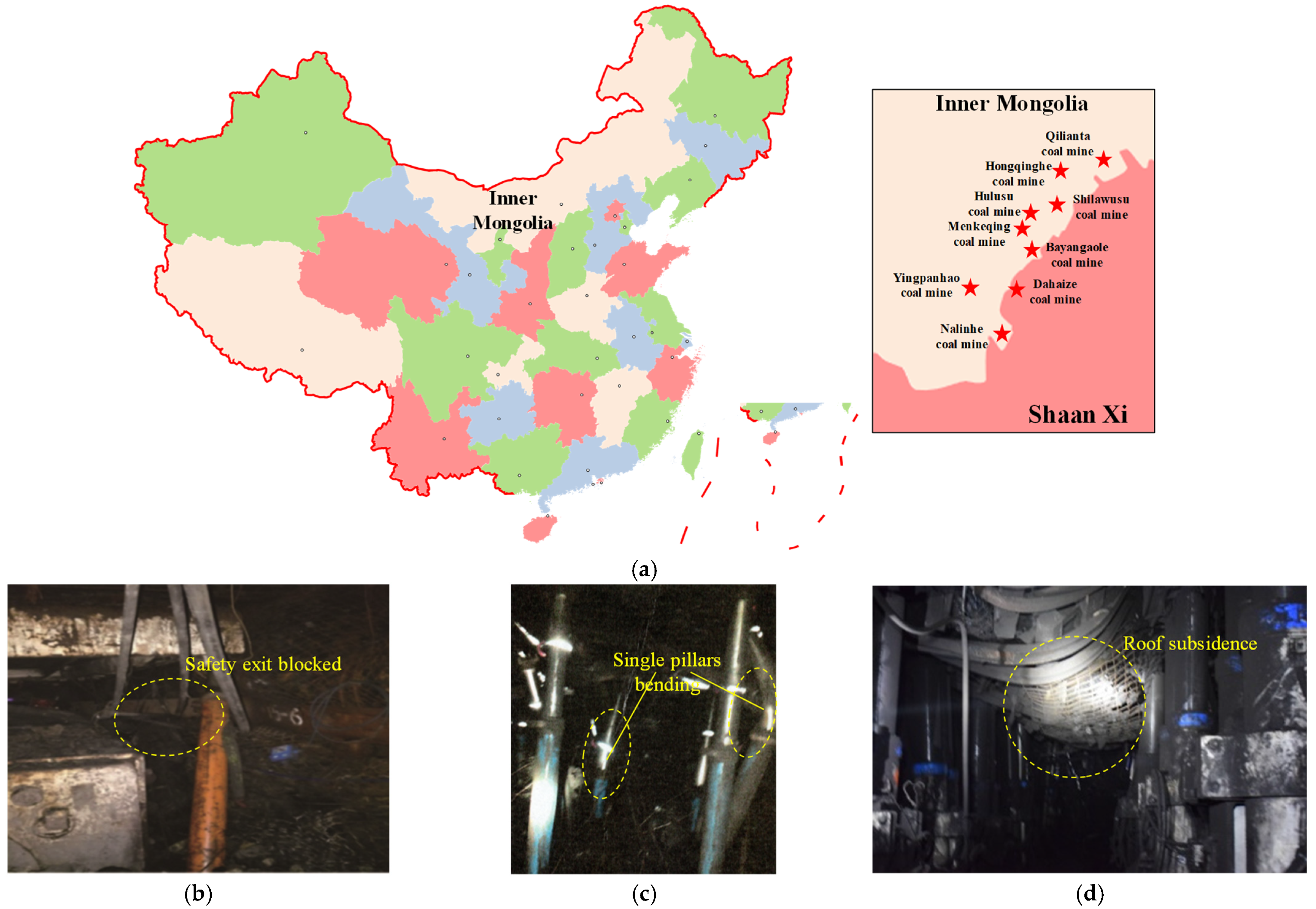



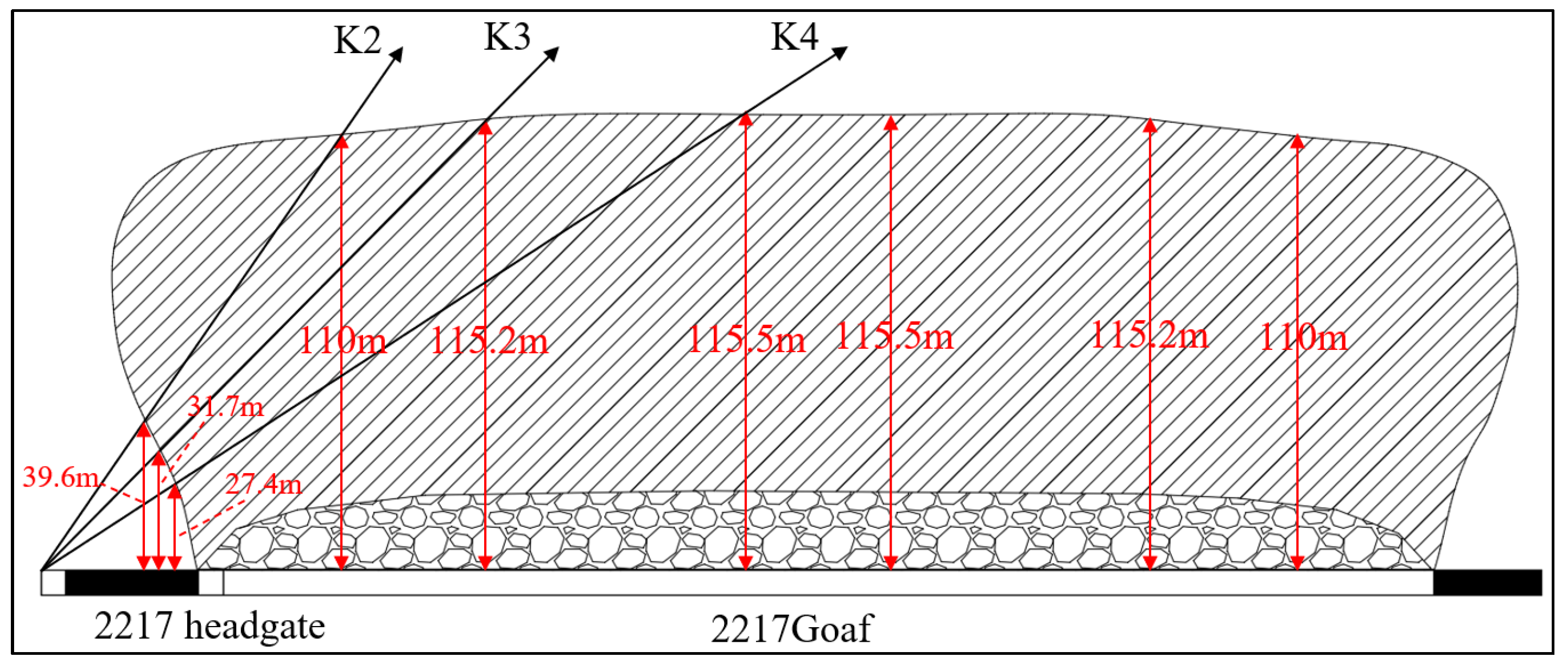
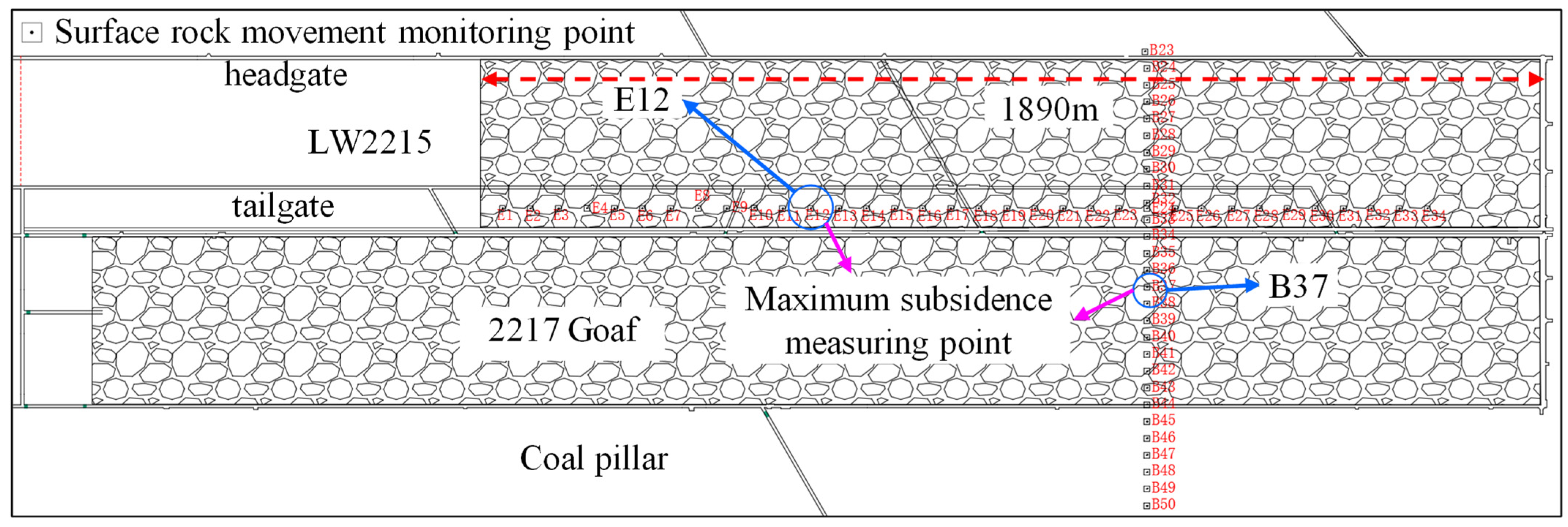

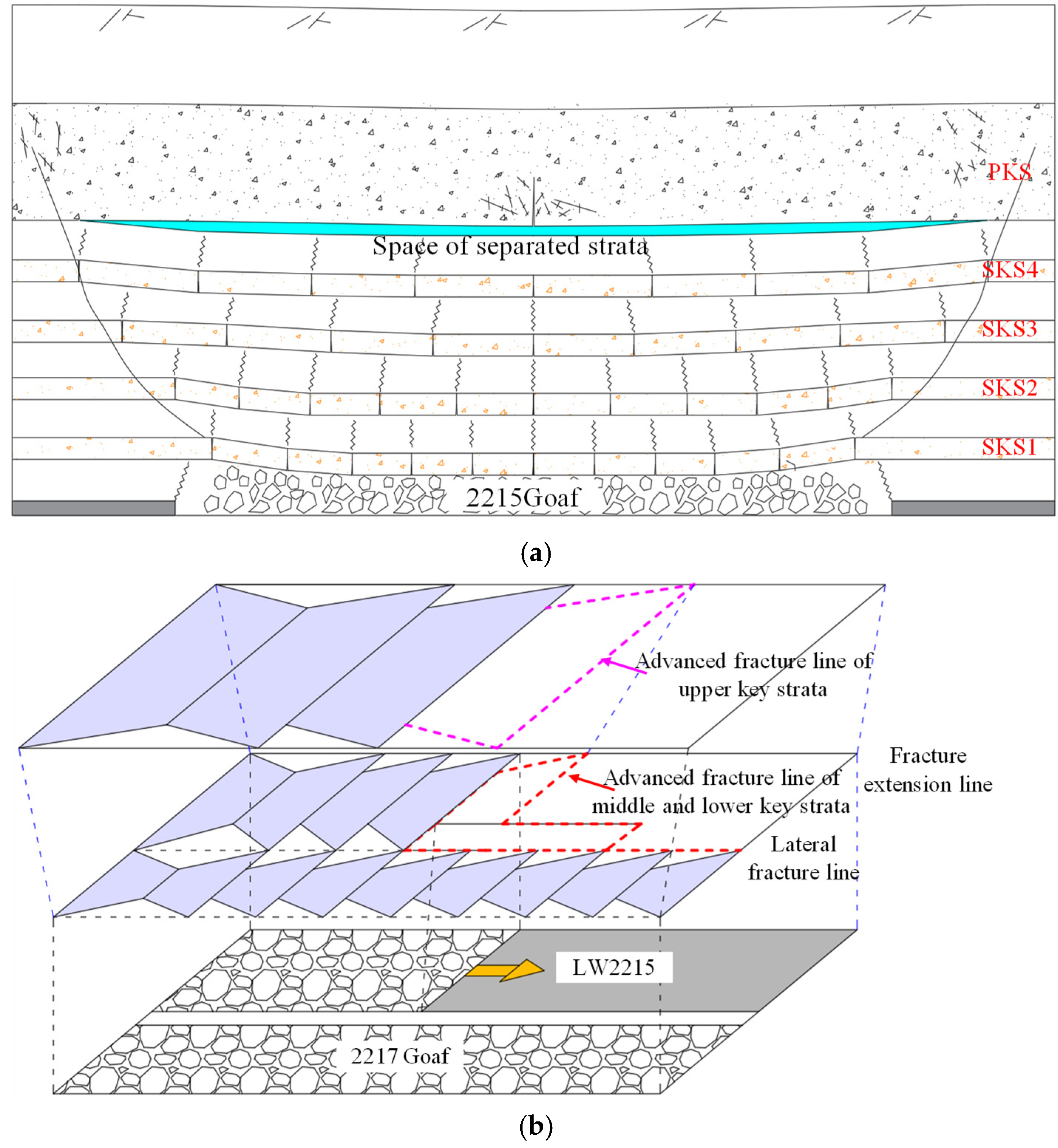
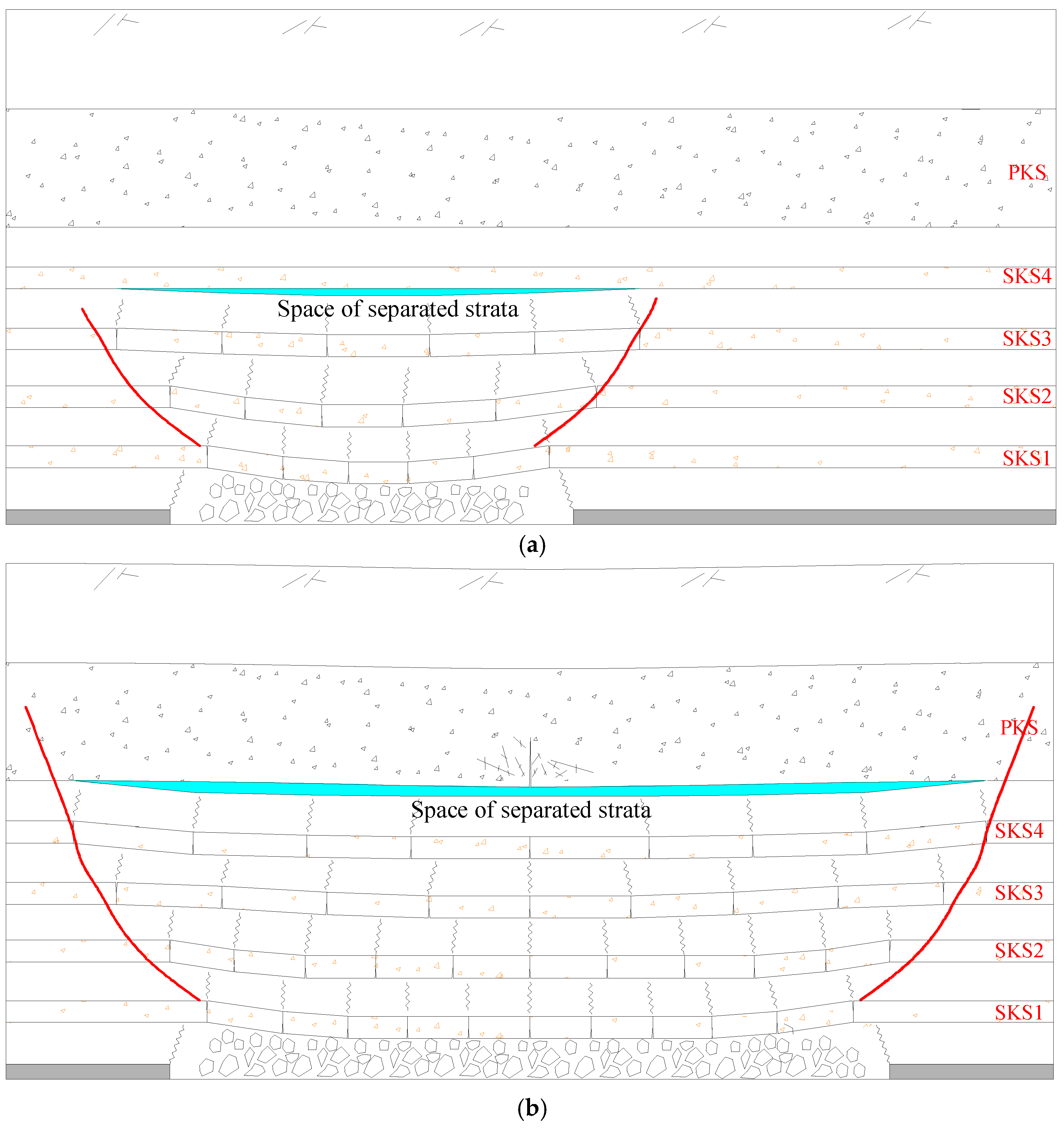
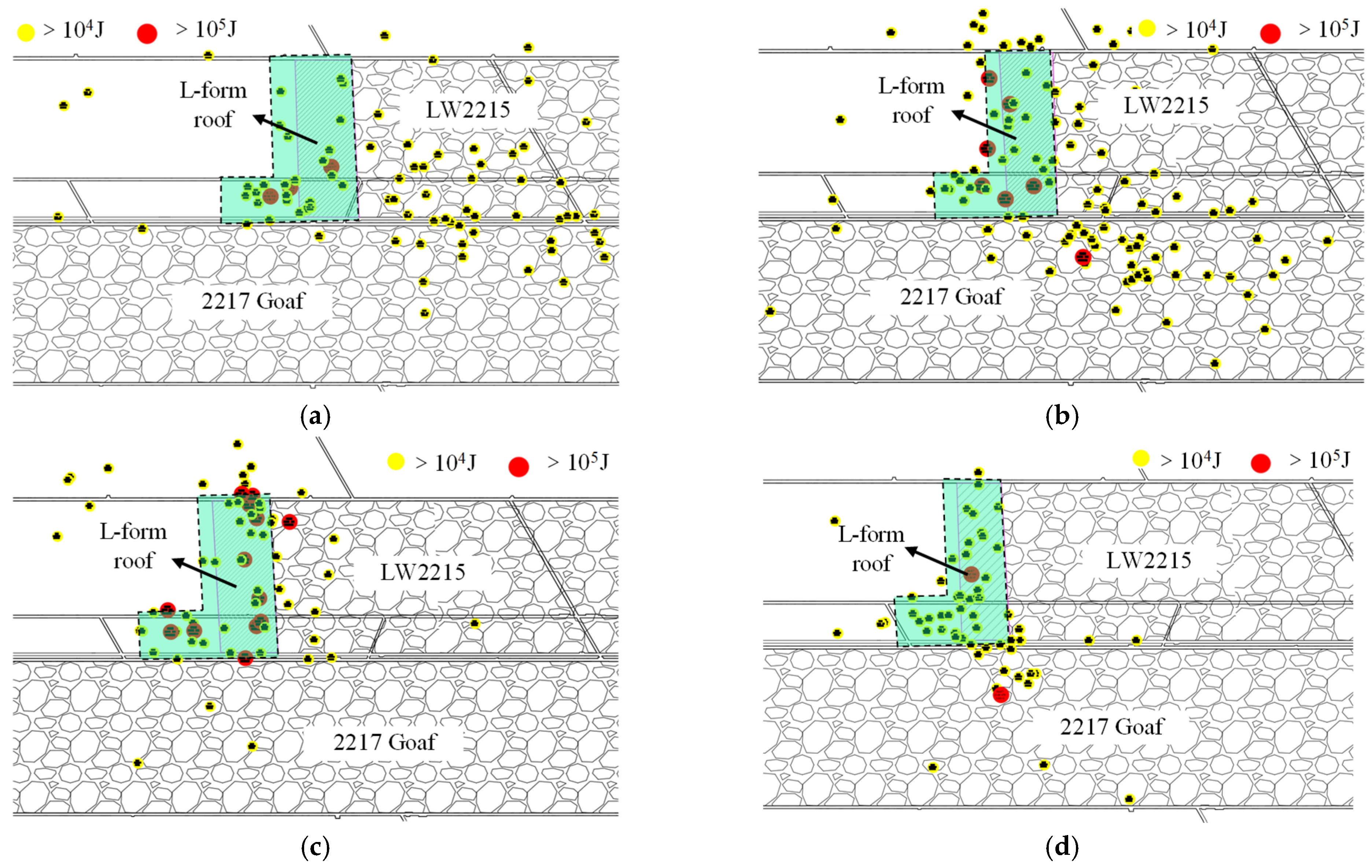



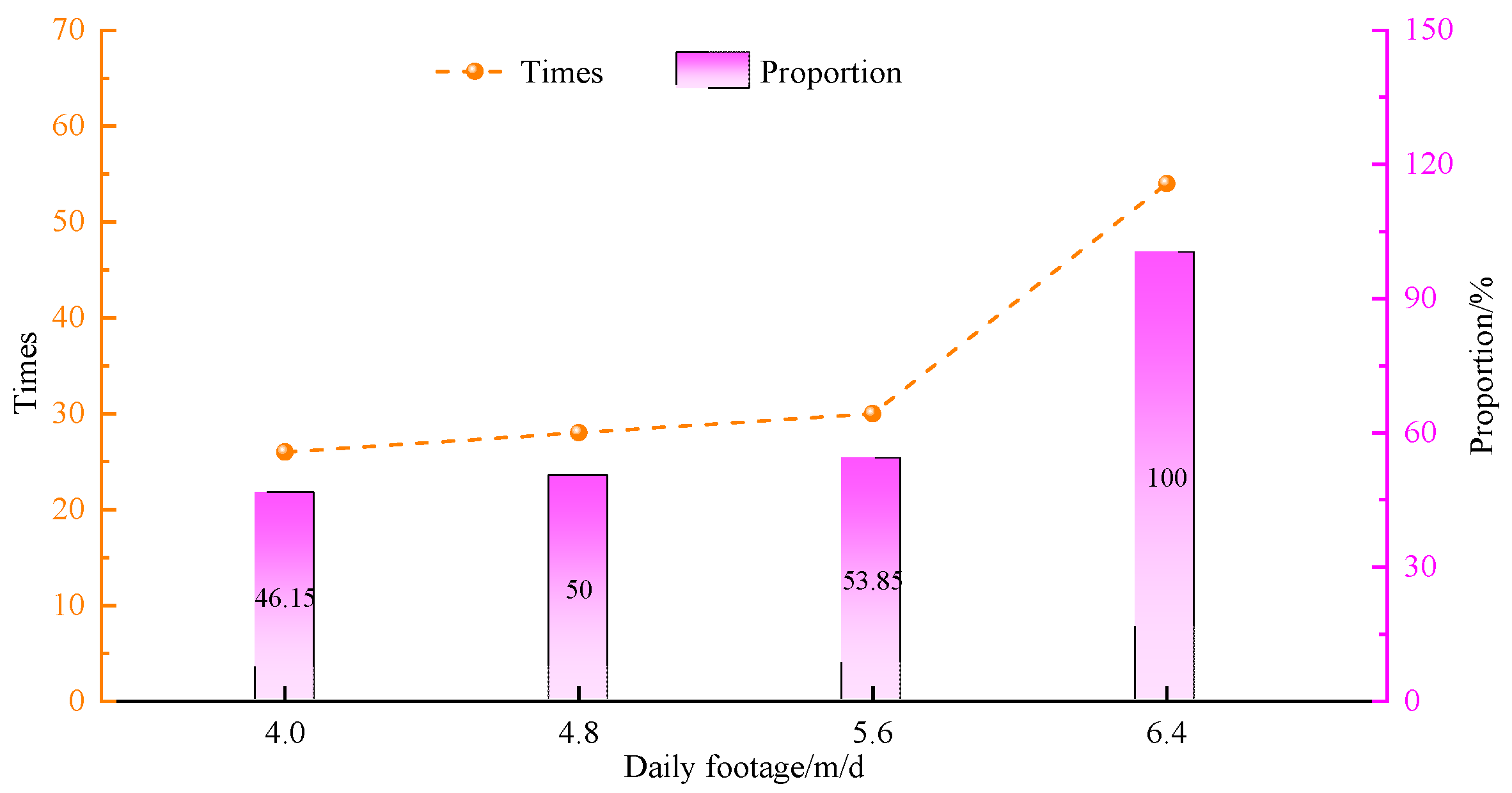
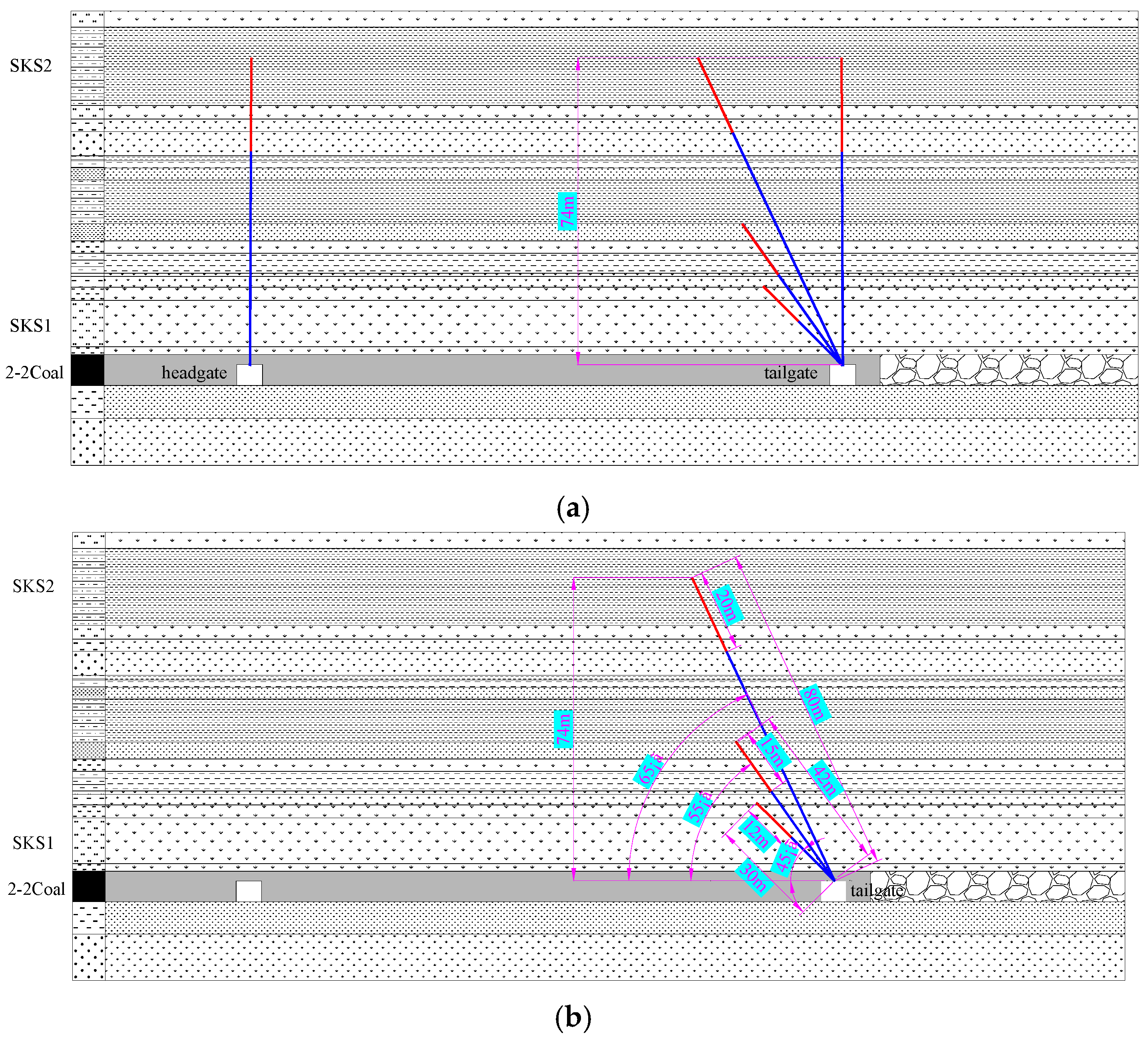
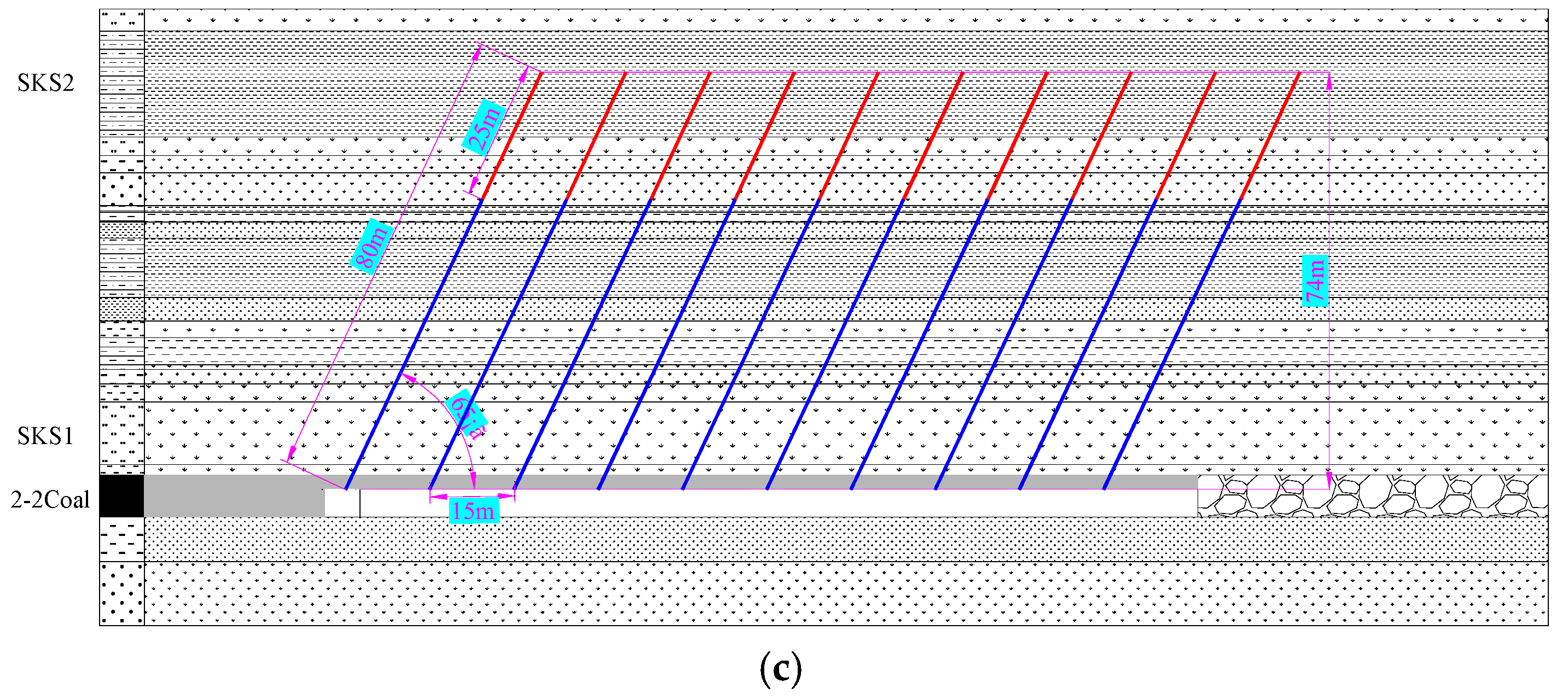

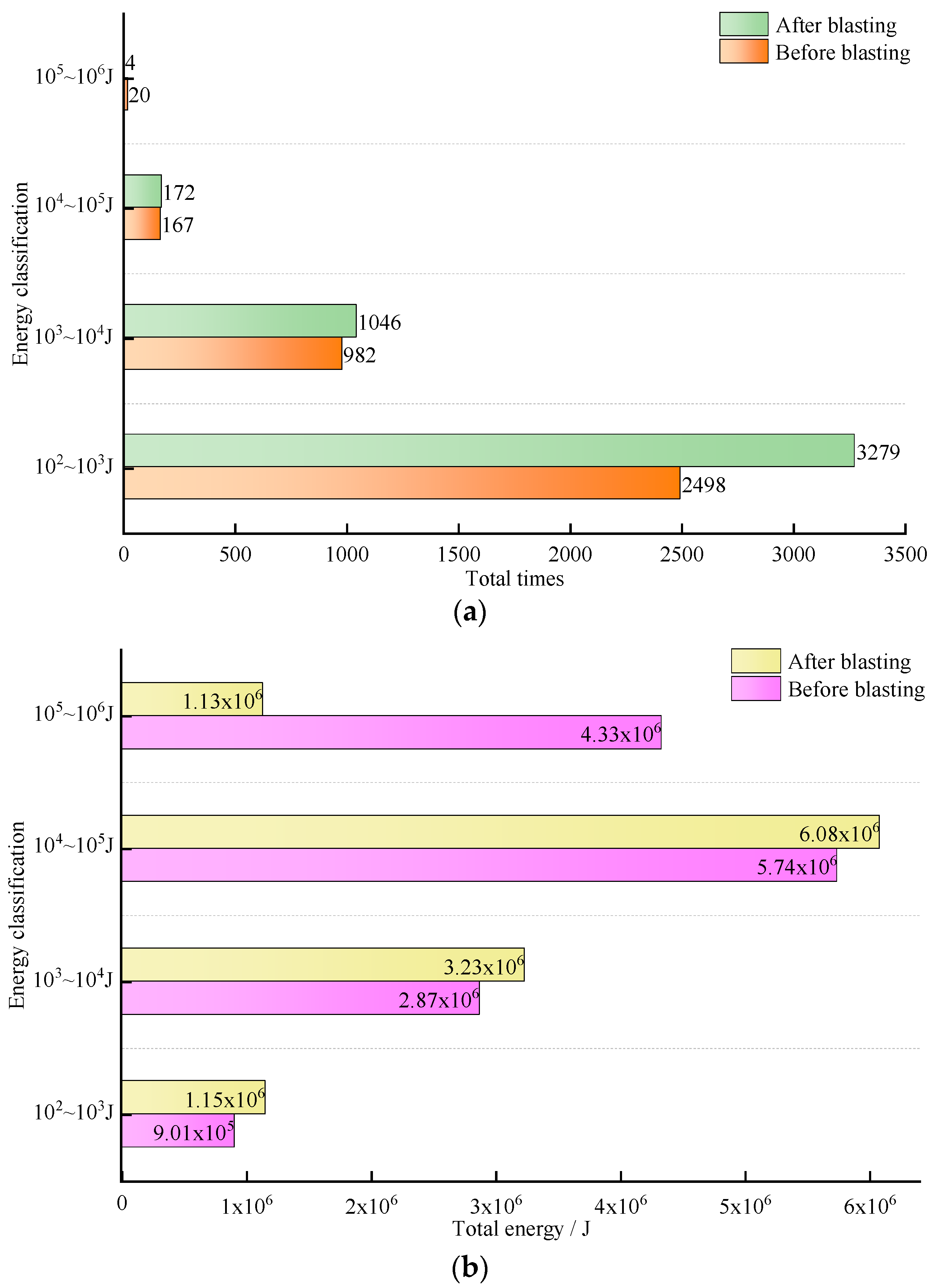
| Location | Number of Events per Month | |||||
|---|---|---|---|---|---|---|
| Working Face Ahead | Behind the Working Face | January | February | March | April | May |
| 40 | 12 | 4 | 12 | 24 | 6 | 6 |
| Footage per month/m | 111.6 | 99.6 | 104.8 | 104.4 | 90.4 | |
| Daily Footage/m | 4.0 | 4.8 | 5.6 | 6.4 |
|---|---|---|---|---|
| Times | 24 | 26 | 28 | 52 |
| Proportion/% | 46.15 | 50.00 | 53.85 | 100 |
| Energy Classification | Changes in Energy and Frequency of Microseismic Events with Different Energy Levels before and after Blasting | |||||
|---|---|---|---|---|---|---|
| Total Times | Total Energy | |||||
| Before Blasting | After Blasting | Proportion of Increase | Before Blasting | After Blasting | Proportion of Increase | |
| 102~103 J | 2498 | 3279 | 31.27% | 9.01 × 105 | 1.15 × 106 | 27.64% |
| 103~104 J | 982 | 1046 | 6.52% | 2.87 × 106 | 3.23 × 106 | 12.54% |
| 104~105 J | 167 | 172 | 2.99% | 5.74 × 106 | 6.08 × 106 | 5.92% |
| 105~106 J | 20 | 4 | −80.00% | 4.33 × 106 | 1.13 × 106 | −73.90% |
Disclaimer/Publisher’s Note: The statements, opinions and data contained in all publications are solely those of the individual author(s) and contributor(s) and not of MDPI and/or the editor(s). MDPI and/or the editor(s) disclaim responsibility for any injury to people or property resulting from any ideas, methods, instructions or products referred to in the content. |
© 2023 by the authors. Licensee MDPI, Basel, Switzerland. This article is an open access article distributed under the terms and conditions of the Creative Commons Attribution (CC BY) license (https://creativecommons.org/licenses/by/4.0/).
Share and Cite
Wang, B.; Feng, G.; Gao, Z.; Ma, J.; Zhu, S.; Bai, J.; Li, Z.; Wu, W. Study on the Mechanism and Prevention of Frequent Mine Seismic Events in Goaf Mining under a Multi-Layer Thick Hard Roof: A Case Study. Minerals 2023, 13, 852. https://doi.org/10.3390/min13070852
Wang B, Feng G, Gao Z, Ma J, Zhu S, Bai J, Li Z, Wu W. Study on the Mechanism and Prevention of Frequent Mine Seismic Events in Goaf Mining under a Multi-Layer Thick Hard Roof: A Case Study. Minerals. 2023; 13(7):852. https://doi.org/10.3390/min13070852
Chicago/Turabian StyleWang, Bo, Guorui Feng, Zhongxiang Gao, Junpeng Ma, Sitao Zhu, Jinwen Bai, Zhu Li, and Wenda Wu. 2023. "Study on the Mechanism and Prevention of Frequent Mine Seismic Events in Goaf Mining under a Multi-Layer Thick Hard Roof: A Case Study" Minerals 13, no. 7: 852. https://doi.org/10.3390/min13070852
APA StyleWang, B., Feng, G., Gao, Z., Ma, J., Zhu, S., Bai, J., Li, Z., & Wu, W. (2023). Study on the Mechanism and Prevention of Frequent Mine Seismic Events in Goaf Mining under a Multi-Layer Thick Hard Roof: A Case Study. Minerals, 13(7), 852. https://doi.org/10.3390/min13070852







